Day 2 of a long weekend of tours, and it was down to the Broads today. We headed out east of Norwich to Strumpshaw Fen to start the day.
As we walked out of the car park, a little group of Long-tailed Tits were making their way through the trees in front of us. There were lots of Blue Tits and Great Tits availing themselves of the feeders by the Visitor Centre, but no sign of any Marsh Tits here today. We had a quick look out on the open water by the Visitor Centre – there were plenty of ducks, mainly Mallard, Teal and Gadwall, with a few Shoveler and plenty of Coot. A lone Black Swan looked slightly out of place!
Setting off onto the reserve, the first bird we came across was a Nuthatch. It kept flying down out of the trees and feeding on the hurdle fencing around the warden’s house – presumably someone must have tucked some food in there for it. A little further down the path, a smart pink male Bullfinch was feeding on the brambles amongst the trees. A Jay flew across in front of us. Then a scan of the trees produced a Treecreeper working its way up a large oak tree.
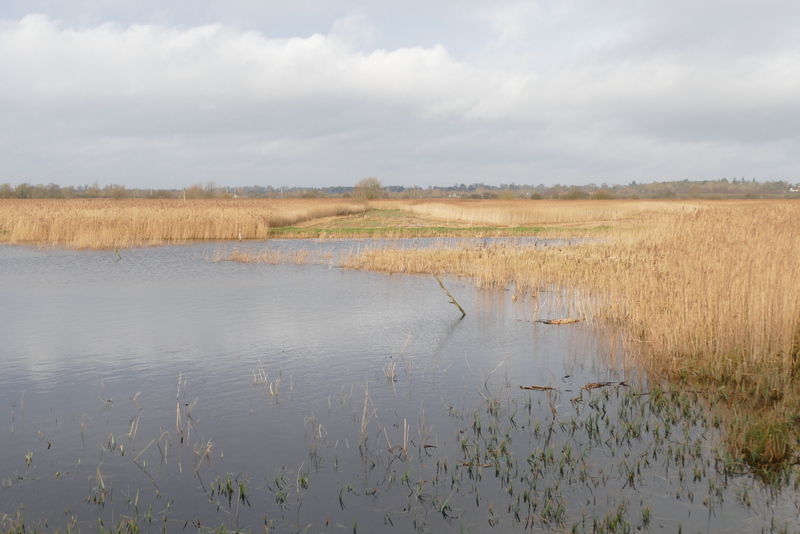 Fen Hide – the pools and reeds were rather quiet here this morning
Fen Hide – the pools and reeds were rather quiet here this morning
We walked out as far as Fen Hide. The hide was very quiet, but unfortunately so were the pools here today. We sat and waited for a short while in the hope that something might appear, but it was not to be. Several Marsh Harriers were out quartering the reedbed, a little wisp of seven Snipe flew up and circled round overhead and a Cetti’s Warbler sang from the bushes. We had quite a lot we wanted to do today, so we decided to move on.
There was more action in the woodland again. As we walked back, we could hear Marsh Tits calling. At first, all we could see was a pair of Blue Tits, apparently already engaged in courtship display. Then higher up in the same oak we finally tracked down the Marsh Tit.
By the old sand pit, we could see movement in the trees so we stopped to look. We spotted a single Lesser Redpoll first, feeding on the cones up in an alder tree, then realised there was another with it, and then a third. A Siskin, appeared higher up and was quickly joined by a second. We had a good look at them through the scope, then something spooked them and about 15 finches flew out – amazing how they were all in there!
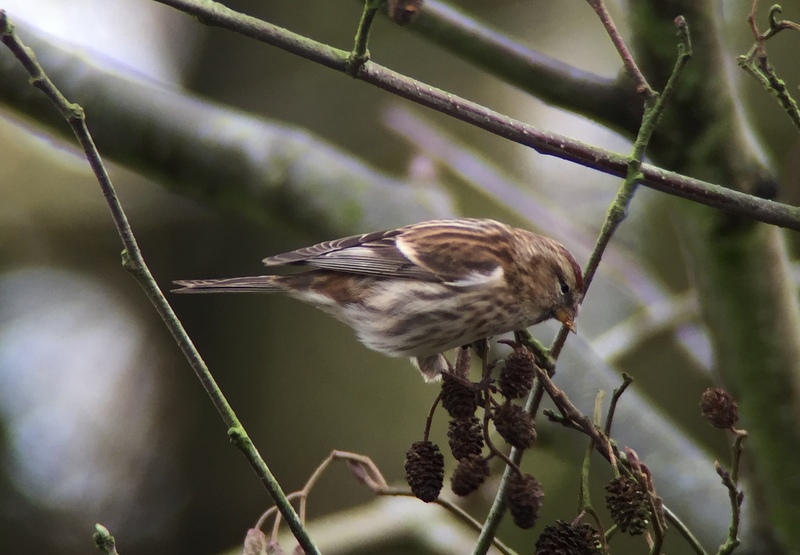 Lesser Redpoll – there was a small party in the alders by the path
Lesser Redpoll – there was a small party in the alders by the path
We made our way round to Buckenham next. As we walked over the railway crossing and out across the marshes, it was clear there were quite a few geese on here today. As well as the resident Canada Geese, there were good numbers of Pink-footed Geese scattered all over the grass.
We could hear Wigeon calling as we walked along the track, and the closer we got to the river, the more of them we could see. There were little groups lining the ditches and a mass of them on the pools. Not the number there can be in some years, possibly due to the mild winter, but there were still plenty of them here. Amongst them, we could see a few Teal and Shoveler and a pair of Shelduck.
 Wigeon – Buckenham is an important site for this species
Wigeon – Buckenham is an important site for this species
As we walked along towards the river, we could hear a pipit calling. It was not the classic ‘seep, seep’ of a Meadow Pipit and not as strident as a Rock Pipit. We saw it fly across, initially landing over by the river bank, before flying up again and coming down onto the edge of one of the pools. We got it in the scope – a Water Pipit.
We followed the track along, round below the river bank towards the old windpump, stopping at intervals to scan the marshes. Over on this side, we started to see White-fronted Geese in with the Pinkfeet. At first, a little group here or there, the more we looked we realised there were actually lots of them scattered across the marshes. The feral Barnacle Geese were also here as usual, accompanied by the odd-looking Ross’s x Barnacle hybrid. But we couldn’t find any sign of the Taiga Bean Geese here today unfortunately.
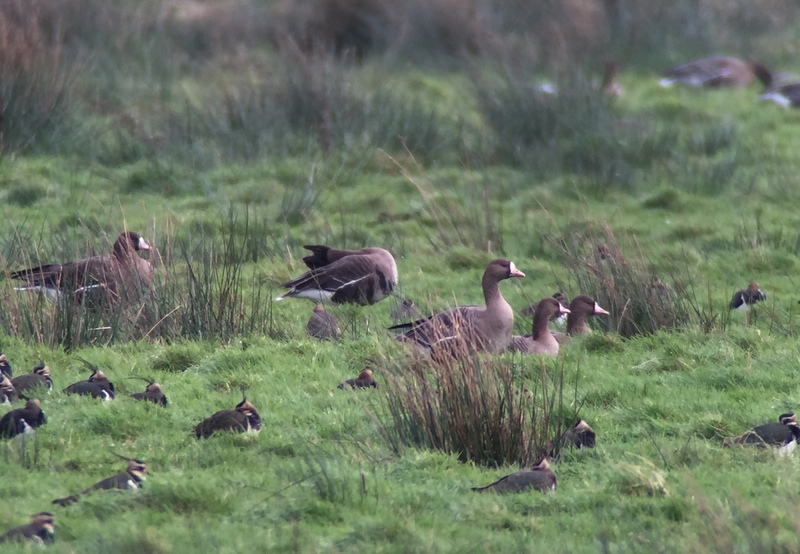 White-fronted Geese – there were plenty of these at Buckenham today
White-fronted Geese – there were plenty of these at Buckenham today
As we turned to walk back, all the Lapwings and Golden Plovers suddenly took flight. We had seen quite a few from the path, but once in the air we realised just how many there actually were. We thought this might have signified the arrival of one of the local Peregrines, but we couldn’t see it. The plovers kept spooking, and it may just have been that they were very skittish. A Buzzard did fly over.
We decided to have a look at Cantley Marshes next, just in case the Bean Geese were round on that side. However, as we got there we encountered someone walking back along the path across the middle of the marshes who recounted how the geese had all flown off just as he made his way back. It was now particularly quiet, so we didn’t linger here.
After lunch, we meandered our way back north, stopping at a few likely sites to look for Cranes. It didn’t take us long to find some – five in total, a group of three together and nearby another two. They all appeared to be adults, rather than the three being a family group. They were a little distant today, but we got them in the scope and had a good look at them, feeding out on the grazing marshes.
 Crane – three of the five out on the marshes on our journey today
Crane – three of the five out on the marshes on our journey today
Our next stop was at Ludham. Even from the main road, we could see the mass of white blobs out on the fields. We turned onto one of the minor roads which criss-cross the old airfield and soon found us pulled up alongside looking at a large herd of wild swans. We had a look from the car first, confirming that a mixture of Bewick’s and Whooper Swans were indeed present, before retreating to a safe spot where we could pull off the road and get out to scope them without disturbing them.
There seemed to be more swans here than in recent weeks – at least 125 today. There seemed to be the same number of Whooper Swans, around 20-25, but an increase in the number of Bewick’s Swans to at least 100. Given that we had seen several arriving from the continent along the coast yesterday, it is likely that cold weather in Europe is finally encouraging more of them to fly over to the UK now.
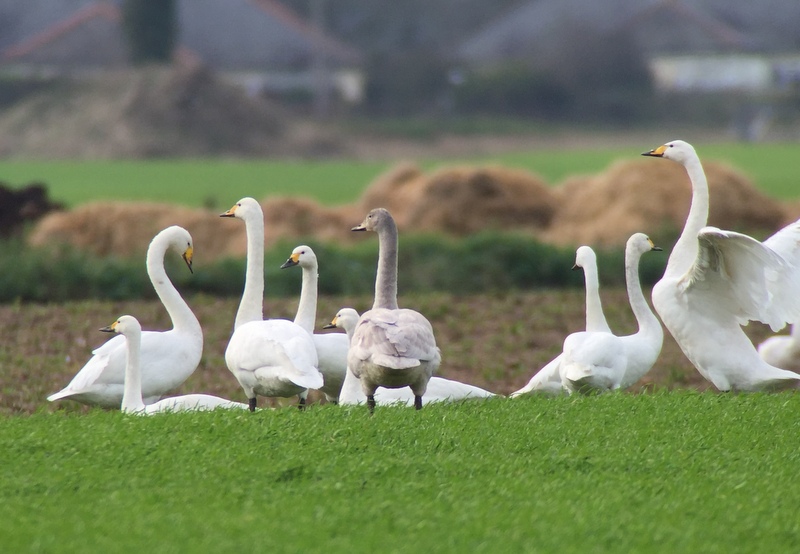 Bewick’s & Whooper Swans – its is always good to see the two together
Bewick’s & Whooper Swans – its is always good to see the two together
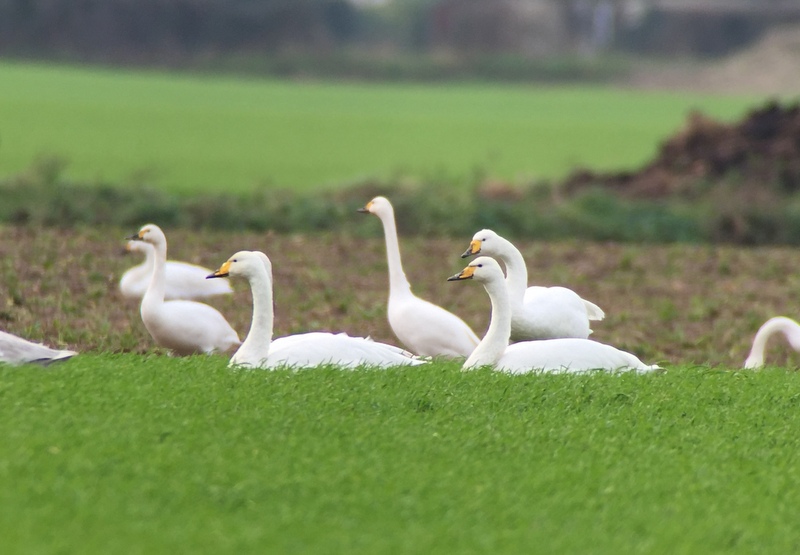 Whooper Swans – in the foreground
Whooper Swans – in the foreground
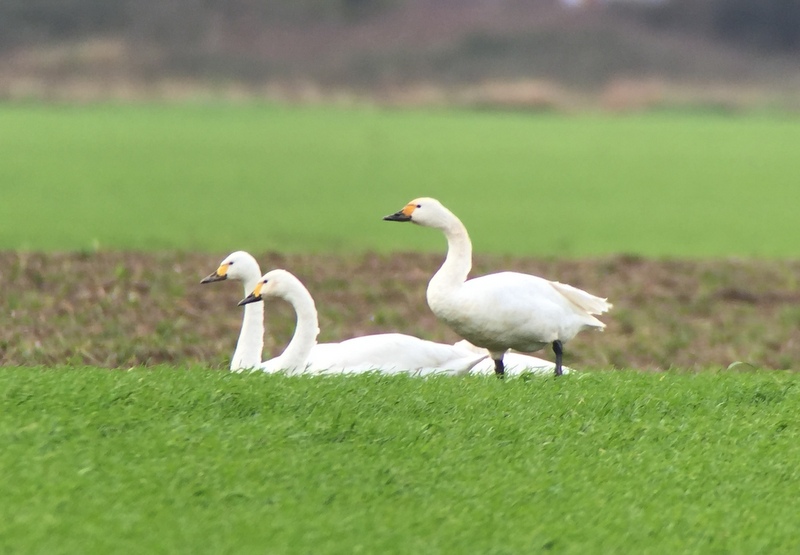 Bewick’s Swans – smaller, with less yellow in the bill
Bewick’s Swans – smaller, with less yellow in the bill
We spent a bit of time watching them. It is always a good opportunity here to see the two species side by side. In direct comparison, Bewick’s Swans are noticeably smaller with shorter necks and bills. The best way to tell them apart is the pattern of yellow on the bill – extending a long way down the bill into a point, like a wedge of cheese, on a Whooper Swan, but more restricted and squared off on a Bewick’s.
Our final stop of the day was at Hickling. We walked out across the marshes towards Stubb Mill, stopping to watch a large family group of Long-tailed Tits in the hedge on the way, loosely accompanied by a single Goldcrest.
Out at the watchpoint, the two Cranes were in their usual place out on the grass when we arrived, though half hidden behind a line of reeds so that they were difficult to pick out at first. They were rather quiet today – not as vocal as last week, when they had been bugling constantly. Perhaps the weather was not too their liking – it had clouded over and started to spit with rain a little by this stage.
There were quite a few Marsh Harriers already out in the bushes in the reeds when we arrived. A steady trickle of more birds arrived. We thought there might have been around 30 in the roost before they all took flight. Immediately we could see there were a lot more than that – eventually we managed to count 60 Marsh Harriers all in the air at the same time! Quite a sight. And still they kept coming, at least another 2-3 before we called it a night.
The first Hen Harrier came in reasonably early tonight. A ringtail, it circled and hung in the air over the fields for a minute or so initially, before turning and flying more directly towards the reeds. We didn’t see the second ringtail Hen Harrier come in, but picked up two together flying around between the bushes in front of the ruined mill later on.
The light was fading but the harriers were still coming when we decided to call it a night, given the weather and a desire to get back. As we walked back along the road – rather wet in places after all the recent rain – we heard more Cranes bugling and turned to see another three dropping down towards the reserve. That made it 10 Cranes for the day, a very respectable total!
Back at the car, while we were packing up, a dumpy shape darting across over the car park in the gloom was a Woodcock – unfortunately too quickly for everyone to get onto it. Another two flew across the road as we headed out, but they were even harder to see. Still, it had been another successful day in the Broads with most of the target species seen.
















